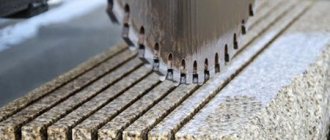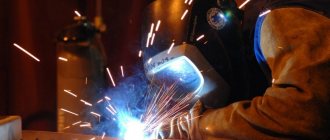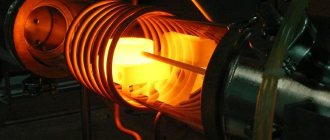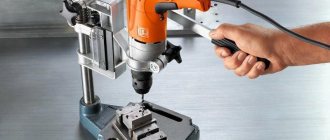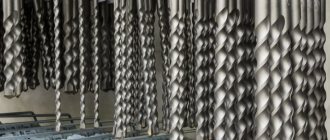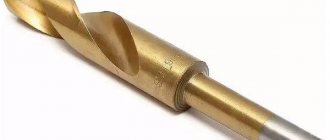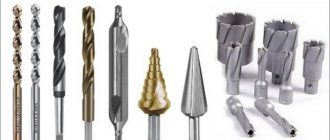When doing repairs, many owners have to perform a wide variety of work, among which drilling is quite common. However, to perform this task well, you must have a suitable drill available. There are no problems with purchasing this device, given that there are a large number of different types on the building materials market.
Therefore, every home craftsman who has purchased a drill should also worry about choosing good drills. Otherwise, they will quickly use up their service life, and you will have to spend money on new ones.
In stores you can find a large number of different drills, differing in length, diameter, and material for which they are intended. And even before you start creating a hole on the surface of the structure, you should decide on the appropriate drill size . To avoid mistakes here, it is necessary to take into account the type of work being performed.
Marking and color of metal drills
Those owners who have had to do drilling at least once, I think, tried to understand what material is used to make these devices, what is meant by the marking on the tool?
What makes it possible to create holes on a surface made of the same material from which the drill itself is made? The efficiency of working with a drill is achieved due to the fact that high-quality and high-strength steel is used as the material for it. But cheap options that are produced on a raw material basis are not able to cope with most of the problems that many owners face.
What does the drill marking mean?
Typically, the marking of a metal drill contains a certain set of letters and numbers . The letter of the main element is usually indicated first, followed by a number that corresponds to the percentage of this element in the material used to produce the drill.
After the first two characters, other elements are often specified.
- P – corresponds to tungsten;
- K - indicates cobalt;
- F - means vanadium;
- M – means molybdenum.
Most often, the labeling does not include the designation of chromium, since this element is necessarily included in the source material, in which its share is about 4%. Among the elements that are missing from the labeling, carbon should be highlighted. For example, if a drill is marked P7M6K6 , then it can be understood that the manufacturer used high-speed steel as a material, which contains tungsten in the amount of 7%, molybdenum - 6%, cobalt - 6%.
If you pay attention to domestic products, there is no such information. However, this applies primarily to products whose diameter is less than 2 mm. Devices with a diameter of 2-3 mm contain information about the geometry and grade of steel. Drills that represent other standard sizes have additional data: they also provide the trademark and sometimes the accuracy class of the drilling product.
What does the drill color mean?
Each of the offered drills can be designed in one of the following colors:
- bright gold;
- black golden;
- grey;
- black.
By the golden color, you can understand that the manufacturer used titanium nitride in the manufacture of the instrument. This operation provides such a drill with increased strength characteristics. Working with such a device will ensure less friction between surfaces.
A black golden hue indicates that the raw material contains a temper, the purpose of which is to eliminate internal stress.
The gray color indicates that the drill in question has not been finished in order to increase the level of protection and strength of the material. From this we can conclude that this device has a low level of workmanship, and therefore it will fail quite soon .
The black color suggests that during the manufacture of the drill, an operation was carried out that involved exposing the product to superheated steam. The benefit of it is to increase its wear resistance.
Types by design
According to their design, drills belonging to the cobalt category are divided into two main types: single- and double-sided.
The first ones, in full accordance with their name, have a cutting part made on only one side. Double-sided drills are essentially two tools in one body. Their design feature is that there is a separate cutting part at both ends. The convenience of using such a tool is that if one of its cutting parts breaks, you can immediately use the second one, simply by reinstalling the drill in the chuck of the equipment used.
Double-sided cobalt drills are intended for installation work on thin-walled materials
Advantages of cobalt drills for metal
Prices for cobalt metal drills are 4-5 times higher than regular ones.
What makes them so popular among home craftsmen? What merits made them so highly rated? A distinctive feature of cobalt is its high melting point . For this reason, metal drills, created on the basis of high-quality high-speed steel alloyed with cobalt, perfectly withstand high temperatures and demonstrate improved mechanical properties. They are characterized by the ability to cope with significant thermal loads, for which they do not have to resort to additional cooling. Similar properties of these metal drills are primarily manifested in situations where it is necessary to create holes in high-strength alloy and high-viscosity steels.
Among other properties that cobalt metal drills have, we should highlight a fairly large sharpening angle of the tip, which is 135 degrees . Thanks to this design of the tip, it becomes possible to drill on smooth round surfaces.
These drilling devices can also be used to create holes in pipes and welds where high precision requirements are important. An important advantage of such metal drills is that when working with them, the master has to exert less physical pressure on them.
Processed materials
Drilling tools made from quick-cutting tools with cobalt additives were originally created to work under conditions of increased heating of cutting edges, which occurs when processing hard and viscous materials. Therefore, it is most advisable to use it when drilling stainless steel and heat-resistant alloys, as well as cast iron products. Another area of application for such a tool is drilling aluminum and magnesium alloys with a high silicon content. In addition, cobalt drills are indispensable when working with materials that have low thermal conductivity, which include a number of thermoplastics and many modern composites.
Drilling with a cobalt drill for metal
Even before you start drilling, you should decide the issue with the cutting mode. To clarify, let us inform you that the main parameters that affect such a mode are the following:
- Cutting speed . It is usually understood as the conditional peripheral speed of a drill for metal, which is demonstrated by the drill in relation to the element being processed. In other words, this parameter means the degree of rotation speed of the drill through metal. For example, it is possible to ensure the same cutting speed of 20 m/min, provided that a drill with a diameter of 1.0 is used for the work, and its rotation speed is 6366 times per minute, or you can use a device whose diameter is 10.0, and the frequency rotation is 637 rpm.
- Submission . We are talking about the degree of movement of the working device in the direction of the drilling axis over a period equal to one revolution. Accordingly, the unit of measurement is millimeter per revolution.
- Torque . This parameter determines the level of load that falls on the metal drill during cutting.
Each of the above parameters influence each other, and when choosing them it is necessary to take into account:
- The material in which the hole needs to be created;
- The material from which the metal drill is made is cobalt;
- Equipment used for work and type of cooling;
- Other factors, which include the degree of surface roughness, contamination, etc.
Features of drilling stainless steels
When creating holes in a stainless steel surface, you have to face problems that boil down to the fact that this material is characterized by sufficient ductility.
Therefore, during operation, the drilling product sticks to the working surface, as a result of which the device heats up too much and subsequently fails. This can be avoided if:
- The problem with heat removal will be solved, for which cooling is used;
- Work will be carried out with drills that best cope with heat and have the ability to better remove chips.
The material used for cobalt metal drilling products is high-speed steel HSSCo (M35) or similar marked. The peculiarity of these drills is that during their manufacture, manufacturers incorporated special properties into them that allow them to effectively create holes in difficult-to-cut stainless steels.
R6M5K5 steel contains 5% cobalt , due to which the drill acquires increased red resistance. We are talking about the property of remaining as hard and resistant to wear as in the normal state, under conditions of heating to a red-hot temperature. A similar effect is achieved through heat treatment.
The production process involves the use of more expensive grinding technology. In other words, this device resembles a spiral, where a grinding machine is used to create grooves. This eliminates the appearance of internal tension on the device, while the surfaces remain smooth. This creates more favorable conditions for chip removal.
The upper part of the working device is located at an angle of 135 degrees and is distinguished by the presence of a cross-shaped point. A similar angle is formed by the working edges of the device. It ensures a reduction in the area of the product's working area. As a result, it is subject to less stress. As for the cross-shaped point of the top, its presence reduces the dead zone between the working edges.
Main characteristics
The most significant characteristics of cobalt drills for stainless steel and other difficult-to-process materials include the following.
- Even when drilling perfectly smooth surfaces, cobalt tools do not move to the side at the initial stage of processing, so at the location of the center of the hole being created, there is no need to make a recess using a core or countersink.
- Holes created using cobalt drills are distinguished not only by exceptional accuracy of geometric parameters, but also by high quality workmanship: there are no burrs or other defects on the inner surface of such holes. In addition, using this tool for drilling stainless steel allows you to avoid such a serious problem as biting the material in the processing area.
- Drills made of high-speed steel alloyed with cobalt are characterized by increased wear resistance.
- If we compare such drills with others, the speed of processing when using them is almost twice as high.
- Due to the mechanical characteristics of the manufacturing material and the design features of such drills, they are successfully used for precise drilling of pipes and welds.
- When drilling stainless steel or any other material using cobalt drills, the master uses less physical effort than when using other types of tools.
Cobalt drills are produced by most manufacturers of equipment and consumables
How to drill stainless steel with a cobalt drill
If you have equipment at your disposal that allows you to accurately select the optimal speed, feed and provide cooling, the following parameters are recommended for working with stainless steel:
Cutting speed. The optimal value would be 10 m/min. The value given will be optimal for drilling most stainless steels. In addition, its use will provide the opportunity to select speeds.
You can determine the speed using the following formula:
n=3180/D , where
for a drill with a diameter of 1.0 – 3180 rpm;
for drill 5.0 already 636 rpm;
Innings. To calculate this parameter you should also use a simple formula:
0.005-0.01d mm/n,
where d is the diameter of the drill.
In simpler terms, in one minute a metal drill with a diameter of 5 mm should create a hole 3 mm deep . When working with a metal drill with a diameter of 10 mm, the hole created should have a size of 1.6 mm.
The problem with overheating is solved with the help of oleic acid, which will act as a coolant.
Features of drilling in the field
If special coolant is not available, olive oil can be used instead. Also suitable here is vegetable, in which the proportion of oleic acid content is only 2 times less - 40%. If none of these substances is at hand, then ordinary lard or fat can come to the rescue: the level of oleic acid in them can reach 44% .
When creating holes, you must set the minimum speed to no more than 200 rpm. Some drill models do not have the ability to select speed. In this case, the problem is solved by using the “on-off” technique, in which a depression in the material is created due to inertia.
Make sure that the feed to the drill is minimal. At the same time, it is important that it is uniform.
